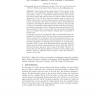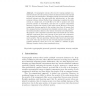74
Voted
CRYPTO
2003
Springer
15 years 6 months ago
2003
Springer
In 1992, Dwork and Naor proposed that e-mail messages be accompanied by easy-to-check proofs of computational effort in order to discourage junk e-mail, now known as spam. They pro...
124
click to vote
CRYPTO
2003
Springer
15 years 6 months ago
2003
Springer
Many popular stream ciphers apply a filter/combiner to the state of one or several LFSRs. Algebraic attacks on such ciphers [10, 11] are possible, if there is a multivariate relat...
CRYPTO
2003
Springer
15 years 6 months ago
2003
Springer
On August 2002, Agrawal, Kayal and Saxena announced the first deterministic and polynomial time primality testing algorithm. For an input n, the AKS algorithm runs in heuristic t...
105
Voted
CRYPTO
2003
Springer
15 years 6 months ago
2003
Springer
We present a new construction based on modular groups. A novel element of our construction is to embed each input into a sequence of matrices with determinant ±1, the product of w...
79
Voted
CRYPTO
2003
Springer
15 years 6 months ago
2003
Springer
Simple password authentication is often used e.g. from an email software application to a remote IMAP server. This is frequently done in a protected peer-to-peer tunnel, e.g. by SS...
99
Voted
CRYPTO
2003
Springer
15 years 6 months ago
2003
Springer
Abstract. Cryptographic systems often involve running multiple concurrent instances of some protocol, where the instances have some amount of joint state and randomness. (Examples ...
79
Voted
CRYPTO
2003
Springer
15 years 6 months ago
2003
Springer
91
Voted
CRYPTO
2003
Springer
15 years 6 months ago
2003
Springer
NTRUEncrypt is unusual among public-key cryptosystems in that, with standard parameters, validly generated ciphertexts can fail to decrypt. This affects the provable security prop...
73
Voted
CRYPTO
2003
Springer
15 years 6 months ago
2003
Springer
In this paper we present a very practical ciphertext-only cryptanalysis of GSM (Global System for Mobile communications) encrypted communication, and various active attacks on the ...
70
Voted
CRYPTO
2003
Springer
15 years 6 months ago
2003
Springer
We give two applications of Nisan–Wigderson-type (“non-cryptographic”) pseudorandom generators in cryptography. Specifically, assuming the existence of an appropriate NW-ty...






